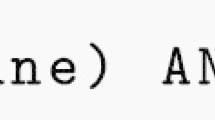Abstract
Transmembrane proteins are some special and important proteins in cells. Because of their importance and specificity, the prediction of the transmembrane regions has very important theoretical and practical significance. At present, the prediction methods are mainly based on the physicochemical property and statistic analysis of amino acids. However, these methods are suitable for some environments but inapplicable for other environments. In this paper, the multi-sources information fusion theory has been introduced to predict the transmembrane regions. The proposed method is test on a data set of transmembrane proteins. The results show that the proposed method has the ability of predicting the transmembrane regions as a good performance and powerful tool.
Similar content being viewed by others
References
S. Topiol and M. Sabio. X-ray structure breakthroughs in the GPCR transmembrane region. Biochemical Pharmacology, 78(2009)1, 11–20.
J. Kyte and R. F. Doolittle. A simple method for displaying the hydropathic character of a protein. Journal of Molecular Biology, 157(1982)1, 105–132.
G. von Heijne. Membrane protein structure prediction: hydrophobicity analysis and the positive-inside rule. Journal of Molecular Biology, 225(1992)2, 487–494.
Y. Deng, Q. Liu, and Y. X. Li. Prediction of transmembrane segments based on fuzzy cluster analysis of amino acids. Acta Chimica Sinica, 62(2004)19, 1968–1972.
Y. Deng. TSFSOM: transmembrane segments prediction by fuzzy self-organizing map. Lecture Notes in Computer Science, 3973(2006), 728–733.
Q. Liu, Y. S. Zhu, B. H. Wang, and Y. X. Li. A HMM-based method to predict the transmembrane regions of beta-barrel membrane proteins. Computational Biology and Chemistry, 27(2003)1, 69–76.
Y. Deng, Q. Liu, and Y. X. Li. Scoring hidden Markov models to discriminate beta-barrel membrane proteins. Computational Biology and Chemistry, 28(2004)3, 189–194.
A. Bernsel, H. Viklund, A. Hennerdal, and A. Elofsson. TOPCONS: consensus prediction of membrane protein topology. Nucleic Acids Research, 37(2009), 465–468.
I. K. Kitsas, L. J. Hadjileontiadis, and S. M. Panas. Transmembrane helix prediction in proteins using hydrophobicity properties and higher-order statistics. Computers in Biology and Medicine, 38(2008)8, 867–880.
A. Hennerdal and A. Elofsson. Rapid membrane protein topology prediction. Bioinformatics, 27(2011)9, 1322–1323.
Y. Wei and C. A. Floudas. Enhanced inter-helical residue contact prediction in transmembrane proteins. Chemical Engineering Science, 66(2011)19, 4356–4369.
Y. Deng, X. Su, D. Wang, and Q. Li. Target recognition based on fuzzy dempster data fusion method. Defence Science Journal, 60(2010)5, 525–530.
Y. Deng, W. Jiang, and R. Sadiq. Modelling contaminant intrusion in water distribution networks: a new similarity-based DST method. Expert Systems with Applications, 38(2011)1, 571–578.
Y. Deng and F. T. S. Chan. A new fuzzy dempster MCDM method and its application in supplier selection. Expert Systems with Applications, 38(2011)8, 9854–9861.
Y. Deng, F. T. S. Chan, Y. Wu, and D. Wang. A new linguistic MCDM method based on multiple-criterion data fusion. Expert Systems with Applications, 38(2011)6, 6985–6993.
A. Dempster. Upper and lower probabilities induced by a multivalued mapping. Annals of Mathematics and Statistics, 38(1967)2, 325–339.
G. Shafer. A Mathematical Theory of Evidence. Princeton, USA, Princeton University Press, 1976.
P. Smets and R. Kennes. The transferable belief model. Artificial Intelligence, 66(1994)3, 191–243.
K. Hofmann and W. Stoffel. TMbase-A database of membrane spanning proteins segments. Biological Chemistry Hoppe-Seyler, 374(1993), 166.
G. E. Tusnady and I. Simon. Principles governing amino acid composition of integral membrane proteins: applications to topology prediction. Journal of Molecular Biology, 283(1998)2, 489–506.
S. Moller, E. V. Kriventseva, and R. Apweiler. A collection of well characterized integral membrane proteins. Bioinformatics, 16(2000)12, 1159–1160.
Author information
Authors and Affiliations
Corresponding author
Additional information
Supported by the National Natural Science Foundation of China (No. 60874105, 61174022), the Program for New Century Excellent Talents in University (No. NCET-08-0345), and the Chongqing Natural Science Foundation (No. CSCT, 2010BA2003).
Communication author: Deng Yong, born in 1975, male, Professor.
About this article
Cite this article
Deng, X., Xu, P. & Deng, Y. The combination prediction of transmembrane regions based on Dempster-Shafer theory of evidence. J. Electron.(China) 29, 142–147 (2012). https://doi.org/10.1007/s11767-012-0797-8
Received:
Revised:
Published:
Issue Date:
DOI: https://doi.org/10.1007/s11767-012-0797-8




